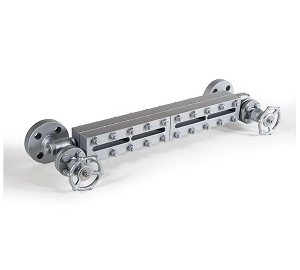Apart from glass tube level gauges, transparent level gauges are always fitted with two plate transparent glasses between which the fluids is contained. The fluids level is indicated as the result of the different transparency of the two media and in some cases (for water steam) , by conveying upwards on the surface of separation(between liquid and gaseous substance ) or source of light located at the back of the gauges , the rays of which are totally reflection down to the observe.

This instrument consists of a metal body, machined to have an internal chamber and one or more front windows (on each side of the gauge). On each window a special high resistance plate transparent glass is applied with sealing joint and metal cover plate hold by bolts and nuts.
The chamber is connected to vessel with cross fittings and flanged, threaded or welded ends. Usually, between the instrument and its connecting ends, valves are fitted to consent shut-off piping and to disassemble the level gauge without to empty the vessel. Drain valves can also be fitted to cross fittings device.
To avoid leakage in case of glass breakage, safety ball-check device can be provide in cross-fittings or shut-off valves. This kind of indicator is suitable for water / steam. To protect glass surfaces from corrosive action of the process fluid, transparent level gauge can be fitted with mica shields or Polytrifluorochloroethylene shields. This kind of indicator is suitable for liquids colorless and very fluid.
In some case (i.e. for water / steam) the best reading is obtained by conveying upwards on the surface of separation (liquid/steam or vapor interface), a source of light, located on the back of the gauge, the rays of which are totally reflected down to the observer.
Transparent level gauges are suitable for almost all installations. In fact they permit: